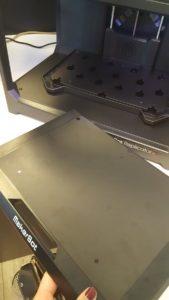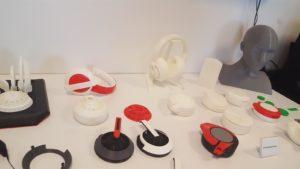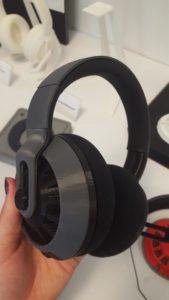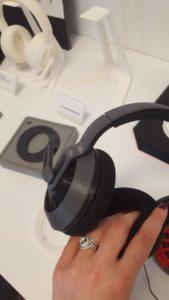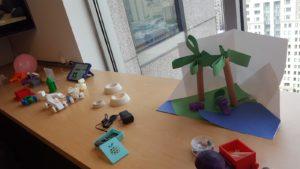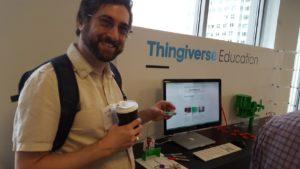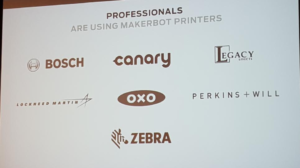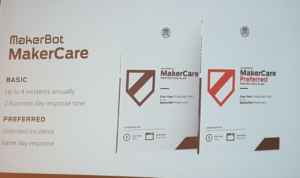MakerBot’s Newest Introductions Take Company Focus from the Consumer to the Professional and Educational
On Tuesday, I stood in MakerBot‘s 21st floor office in bustling Brooklyn, New York. The views out the windows were excellent; at that height, we were afforded a clear look over the city as well as some of its famous bridges. Stepping back from the busy announcement to enjoy the view out the window, I understood a bit of the company’s mentality that day; they too had needed to step away from the frantic pace of industry to quietly observe. Following an intensive listening tour spurred on by CEO Jonathan Jaglom kicked off early in his tenure at the company’s helm, MakerBot has now formally shifted its focus.
As recent layoffs and struggles have only highlighted a less-than-ideal trajectory for the company whose name used to be synonymous with desktop 3D printing, it was clear that the company had needed a shift. It has also becoming ever clearer that those looking from the outside in to MakerBot have not been the only ones aware of this need. Since the beginning of this year, Jaglom and the MakerBot team have been teasing announcements set to reshape the company. From moves like the creation of a developers’ portal to allow for more customization of Thingiverse to the surprising move of production to a contract manufacturer, MakerBot has been easing its way to a new focus of operations.
 It’s become more official this week: the vision has changed. The previous view of the ubiquity of home 3D printers has been accepted as an unlikelihood in the near future, and so we are now seeing the view of the consumer change. While MakerBot will continue to make desktop 3D printers, they are now being targeted to two primary audiences, neither of which is the home consumer. As previously introduced, MakerBot will be focusing on professional and educational users with the company’s recent splash announcement of two new 3D printers, new software, and new material.
It’s become more official this week: the vision has changed. The previous view of the ubiquity of home 3D printers has been accepted as an unlikelihood in the near future, and so we are now seeing the view of the consumer change. While MakerBot will continue to make desktop 3D printers, they are now being targeted to two primary audiences, neither of which is the home consumer. As previously introduced, MakerBot will be focusing on professional and educational users with the company’s recent splash announcement of two new 3D printers, new software, and new material.
“We met. We observed. We listened,” said Jaglom on Tuesday, noting that the listening tour encompassed visits to about 80 customers/prospective customers/partners to better understand not just the needs of users, but how MakerBot can serve those needs.
Taking users’ needs down to the basics, the MakerBot team came to understand that a key concern for professional users is the pace of iteration possible, while educational users seek all around content availability, ease of use, and the ability to unleash creativity in the classroom and for students to learn from their own mistakes.
“We’re focusing on user-centric solutions. Content, workflow, output,” Jaglom continued. “It would be wrong to position MakerBot as an output-only company. …We are trying to understand what is key to that user to bring the best possible experience.”
- The Flex Build Plate snaps on and off
- The Flex Build Plate was designed to put an end to the use of blue tape
MakerBot is taking this approach very seriously, and only went through with this week’s announcement following lots of listening — followed by even more product testing. To fully conceive of what matters to users, the team really did their research, including putting their new hardware and software right into the hands of targeted users. Below is a video of MakerBot’s Shiann Yamin telling 3DPrint.com about the new hardware offerings announced this week, including a demonstration of the new Flex Build Plate:
Speaking about MakerBot for Professionals, Vice President of Digital Products Carla Echevarria told the gathered journalists present Tuesday morning about the company’s approach for the suite of products, noting of the cyclical process for designers that “accelerating this process is really what we’ve focused our solutions on.” The iterative design process requires several steps, and MakerBot is seeking to streamline and ease these as much as possible. Echevarria noted that what matters to professionals can be broken down into a few key concerns:
- Reliability
- Workflow Speed
- Material Quality
- Cost Effectiveness
- Direct Access
“Designers don’t have time to troubleshoot or figure out why something isn’t working,” she continued. “We focused a lot of our efforts to make sure the products we’re showing you today are reliable, are professional quality. Being able to work seamlessly is very, very important; software helps optimize that process. When you’re prototyping a physical product that’s going to go into mass production, you want the prototype to resemble the final product as closely as possible, let the designer feel that what they hold in their hand is what they saw in their head. If you’re going to prototype something 30, 50 times, cost is important. Finally, direct access is key, designers don’t want to send their designs to a service bureau, every minute counts coming to a product launch.”
- Headphones were used as a professional iterative design case study
- A 3D printed prototype of a headphone design
To further illustrate the power of design capabilities for professionals, MakerBot introduced James Krause, Director of Industrial Design, Canary. This NYC-based tech company was launching their Canary Flex the same day as the MakerBot announcement, and was present at MakerBot HQ to highlight how the new Replicator+ 3D printer had helped their Flex come to fruition. The Flex, an all-in-one wire-free indoor-outdoor security device, found design success through MakerBot’s new software introduction, as MakerBot Print’s auto plate loading software helped to quickly iterate upon designs. Stay tuned for more details about the Canary Flex!
Not presenting in the morning session, but present to show off 3D printed iterations, was Dallas-based Gossamer with its high-speed Teal drone. The company, started by a very impressive and inventive teenager, used MakerBot technology to iterate the fast flyer. MakerBot has also featured Teal drones in a case study on their own site, offering more insights into the development of this drone that can exceed speeds of 70 mph.
Turning to the educational side, Drew Lentz, Director of MakerBot Learning, presented solutions for educators. He broke down educators’ concerns to these primary areas:
- Classroom-Ready Resources
- Community & Support
- Ease of Use
- Reliability
From content, Lentz noted, educators seek complete lesson plans including 3D printable content; from software, easy-to-use programs that get teachers printing quickly; and from hardware, classroom-friendly and student-safe machines are necessary. Furthermore, “saving time and saving money are also applicable to educators, not just professionals,” helping to expand that sense of accessibility.
“We had to step back,” Lentz said,” facilitate the conversation from expert to novice — MakerBot is not full of teachers, we had to listen to those in the classroom every day.”
- Mike Parker, holding a Thingiverse Education design he had helped to create
By presenting Thingiverse Education, MakerBot is allowing for not just 3D printable models for classroom use, but free lessons that are compatible with standard curricula — starting with more than 100 available right from launch, incorporating 3D files, grading rubrics, handouts, quizzes, and discussion questions. Lentz pointed out that MakerBot is seeking to facilitate a sense of community in which educators can exchange project ideas and best practices, and that encompasses Thingiverse Developer to allow developers to jump right in to Thingiverse Education as well.
Another goal is to get teachers more comfortable more quickly with the idea of 3D printing in their classrooms, which means streamlining the software experience. While some teachers have let 3D printers sit in their boxes, unopened at the back of classrooms, waiting to have time to unbox and figure out how to get it running, MakerBot sought to enhance the out of the box experience. The intent is to have the newly redesigned MakerBot Mobile so easy to use that its new “guided setup process ensures that teachers and students can start printing quickly and easily, right out of the box,” Lentz said, adding that the goal is to “overcome intimidation of boxed 3D printer sitting in the corner of a classroom, break down that barrier using the app – take the printer out of the box, connect to smartphone, get printing in under 10 minutes. A teacher can do it in the morning before school, no need to wait until summer break.”
The MakerBot team gathered Tuesday morning embodied the best of the spirit that has long driven the maker movement, hopefully representing a strong bounce back for the long-beleaguered company. MakerBot has been making definite attempts to shake off previous negatives (even noting that now the Smart Extruder+, the follow-up to the disastrous first Smart Extruder, has reached an 87% customer satisfaction rating — which will hopefully keep rising, as these extruders ship standard with the newly introduced machines), and we are still seeing the company’s original units serving as the basis for much copying (a trend Jaglom noted as “flattering”). Conversations with MakerBot’s current leadership team and on-floor representatives always leaves a great impression — these individuals form hard-working teams, and they do give the very real impression that they want to do the best they can for their customers going forward.
[All photos/video: taken on-site at MakerBot by Sarah Goehrke for 3DPrint.com]- Companies using MakerBot’s professional 3D printing offerings
- MakerBot Print allows for loading of multiple build plates
- A look at material performance for the newly introduced Tough PLA
- MakerBot Care offers two varieties of coverage
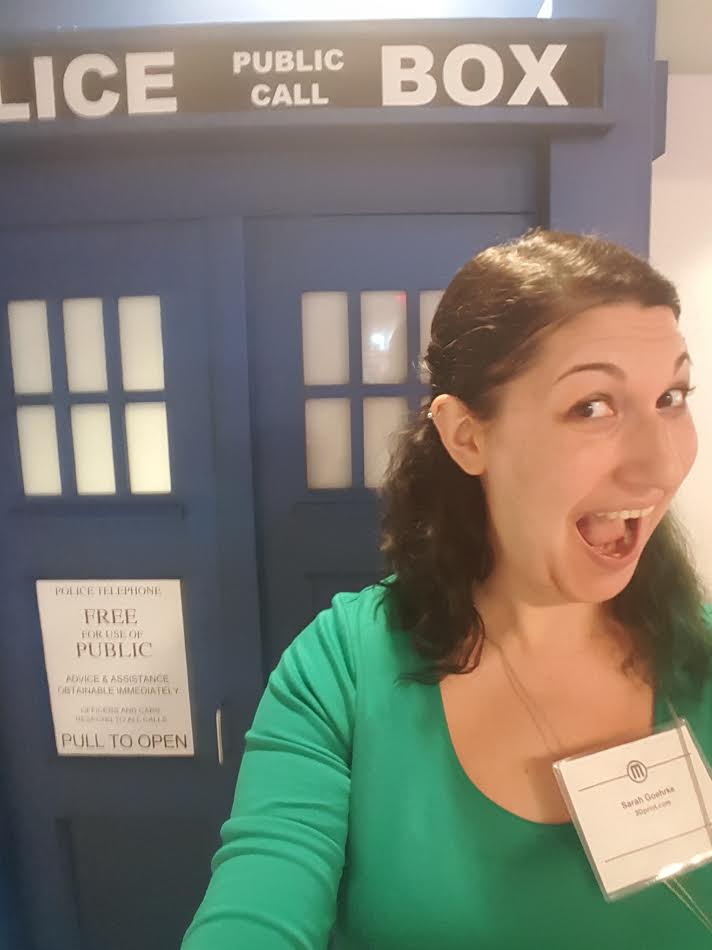
There is also a full-sized, functioning (as a door) TARDIS at the MakerBot office. I found this very exciting.
Subscribe to Our Email Newsletter
Stay up-to-date on all the latest news from the 3D printing industry and receive information and offers from third party vendors.
Print Services
Upload your 3D Models and get them printed quickly and efficiently.
You May Also Like
Making Space: Stratasys Global Director of Aerospace & Defense Conrad Smith Discusses the Space Supply Chain Council
Of all the many verticals that have been significant additive manufacturing (AM) adopters, few have been more deeply influenced by the incorporation of AM into their workflows than the space...
EOS in India: AM’s Rising Star
EOS is doubling down on India. With a growing base of aerospace startups, new government policies, and a massive engineering workforce, India is quickly becoming one of the most important...
PostProcess CEO on Why the “Dirty Little Secret” of 3D Printing Can’t Be Ignored Anymore
If you’ve ever peeked behind the scenes of a 3D printing lab, you might have caught a glimpse of the post-processing room; maybe it’s messy, maybe hidden behind a mysterious...
Stratasys & Automation Intelligence Open North American Tooling Center in Flint
Stratasys has opened the North American Stratasys Tooling Center (NASTC) in Flint, Michigan, together with automation integrator and software firm Automation Intelligence. Stratasys wants the new center to help reduce...




